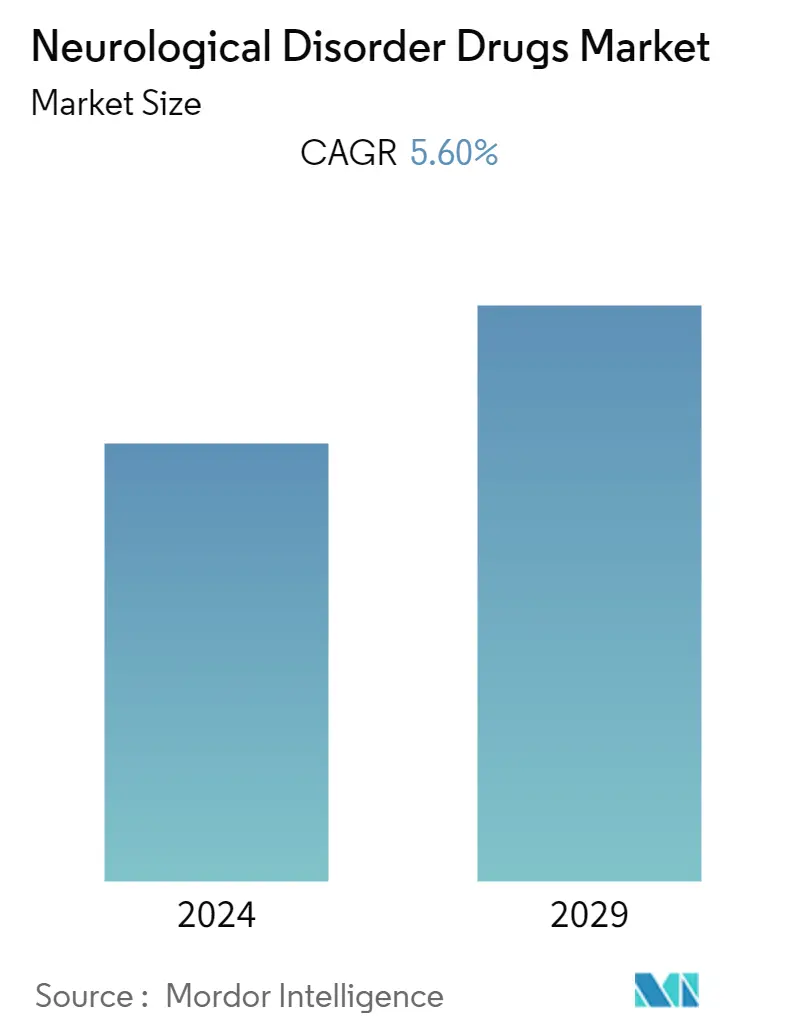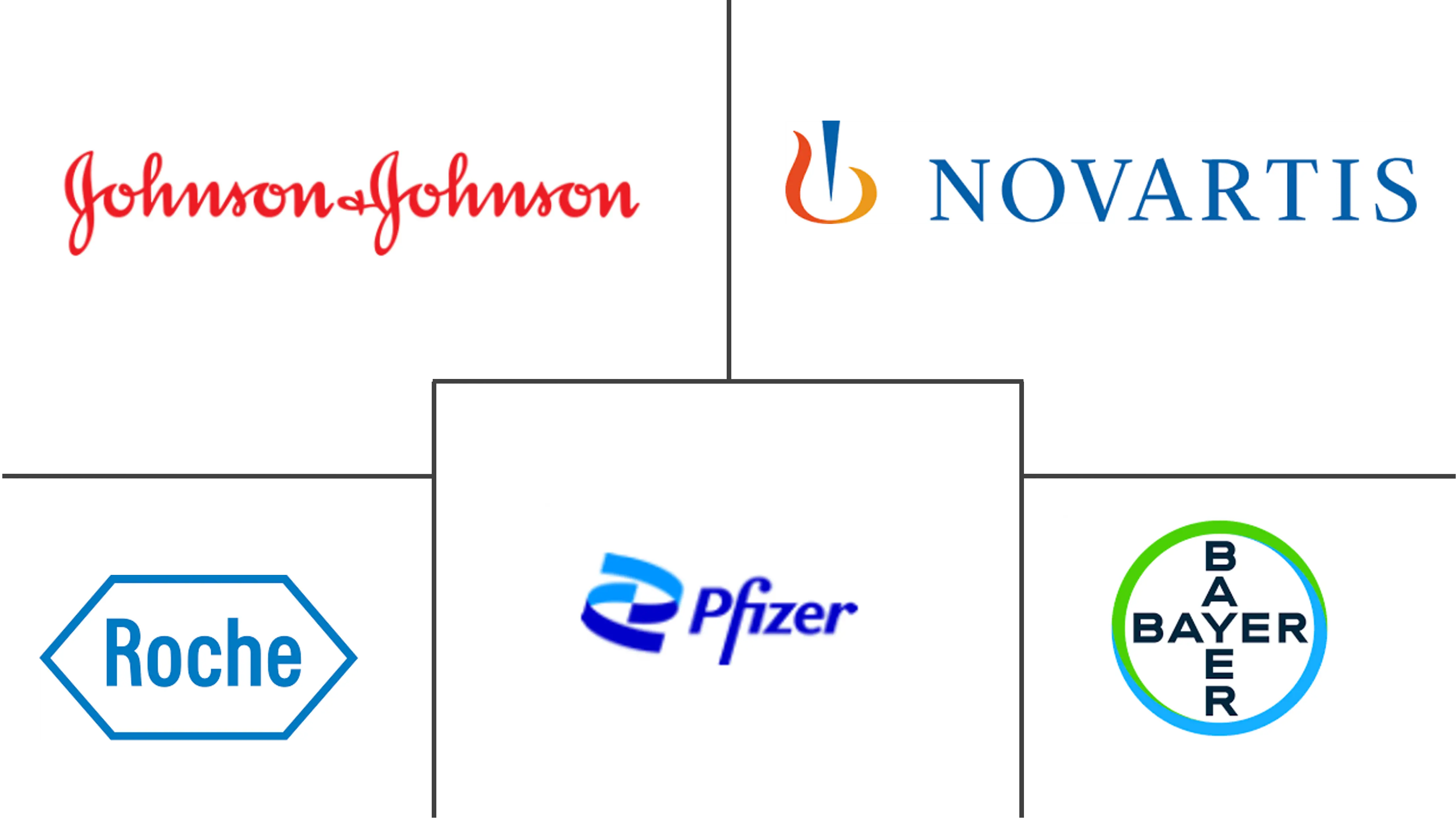Market Size of Neurological Disorder Drugs Industry

| Study Period | 2019 - 2029 |
| Base Year For Estimation | 2023 |
| Forecast Data Period | 2024 - 2029 |
| CAGR | 5.60 % |
| Fastest Growing Market | Asia Pacific |
| Largest Market | North America |
Major Players
*Disclaimer: Major Players sorted in no particular order |
Neurological Disorder Drugs Market Analysis
The Neurological Disorder Drugs Market is expected to register a CAGR of 5.6% during the forecast period.
The COVID-19 pandemic hampered the progress of neurological healthcare services for patients worldwide in the initial phases of the pandemic. However, treatment resumed following government initiatives. The focus on mental health, depression, and anxiety increased post-COVID as it demanded more neurological care. For instance, an article published by Frontiers in Psychiatry in August 2022 stated that around 18.4% of people in the United States experienced moderate to severe depression after suffering from COVID-19 disease. Similarly, according to a KFF/CNN survey of March 2023, symptoms of anxiety and depression elevated among women, which is 36% compared to men's at 28% in February 2023. The same source also stated that nearly 40% of all mental health and substance use disorder outpatient visits were delivered through telehealth in 2021. Hence, the pandemic led to an increase in neurological disorders among people, which significantly had a significant impact on market growth.
The factors expected to drive the market growth include the increasing prevalence of neurological diseases, rising awareness for early disease diagnosis, and increasing R&D for neurological disorders. Worldwide, neurological illnesses are a leading cause of disability and mortality. Neurodegenerative disorders such as Alzheimer's disease (AD), Parkinson's disease (PD), and amyotrophic lateral sclerosis (ALS) cause significant morbidity and mortality in the aged population worldwide. Many organizations across the globe are taking substantial steps to reduce the incidence of neurological diseases. For instance, according to the WHO report published in April 2022, the intersectoral global action plan on epilepsy and other neurological disorders 2022-2031 represents an unprecedented opportunity to address the burden of neurological illnesses throughout and after the pandemic. This is expected to create a high demand for neurological drugs. Such initiatives to reduce neurological disorders are expected to drive the market during the forecast period.
The market for neurological drugs is predicted to rise due to the high prevalence of neurological illnesses such as dementia, autism, Alzheimer's disease, and other rare diseases. For instance, according to the WHO's data published in April 2023, about 55 million people worldwide have dementia, and this is likely to rise to 78 million by 2030 and 139 million by 2050. The WHO also stated that the global financial burden of dementia was estimated to be USD 1.3 trillion in 2019 and is expected to climb to USD 2.8 trillion by 2030. Thus, this is projected to contribute to the market growth over the forecast period.
Furthermore, extensive research and developments for Alzheimer's are also projected to contribute to the market growth. For instance, an article published by Alzheimer's Association in May 2022 stated that as of January 25, 2022, there were 143 agents in 172 clinical trials for AD. The pipeline included 31 agents in 47 trials in Phase 3, 82 agents in 94 trials in Phase 2, and 30 agents in 31 trials in Phase 1. Advances in drug design, outcome measures, use of biomarkers, and trial conduct promise to accelerate the delivery of new and better treatments for patients with Alzheimer's. Such R&D initiatives are expected to boost the market for neurological drugs. Drug approvals for neurological disorders are also likely to drive market growth. For instance, in May 2023, Biophore India Pharmaceuticals announced that it had received approval from the Central Drugs Standard Control Organisation (CDSCO) to manufacture and market Cannabidiol Solution 100mg/ml for neuro disorders in India.
However, the high cost of diagnosis and treatment as well as stringent regulations associated with the neurological drugs is expected to restrain the market's growth over the forecast period.
Neurological Disorder Drugs Industry Segmentation
As per the scope of this report, neurological disorder drugs are used to treat a neurological or neuromuscular disorder of the nervous system, such as Parkinson's disease, Alzheimer's disease, and traumatic brain injuries.
The Neurological Disorder Drugs Market is segmented by Disorders (Epilepsy, Alzheimer's Disease, Parkinson's Disease, Multiple Sclerosis, Cerebrovascular Disease, and Other Disorders), Drug Type (Cholinesterase Inhibitors, NMDA Receptor Antagonists, Antiepileptic, Antipsychotic & Antidepressant, and Other Drugs Type), Distribution Channel (Hospital Pharmacies, Online Pharmacies, Retail Pharmacies) and Geography (North America, Europe, Asia-Pacific, Middle East and Africa, and South America). The report also covers the estimated market sizes and trends for 17 countries across significant regions globally. The report offers the value (in USD million) for the above segments.
| By Disorders | |
| Epilepsy | |
| Alzheimer's Disease | |
| Parkinson's Disease | |
| Multiple Sclerosis | |
| Cerebrovascular Disease | |
| Other Disorders |
| By Drug Type | |
| Cholinesterase Inhibitors | |
| NMDA Receptor Antagonists | |
| Antiepileptic | |
| Antipsychotic and Antidepressant | |
| Other Drugs Type |
| By Distribution Channels | |
| Hospital Pharmacies | |
| Online Pharmacies | |
| Retail Pharmacies |
| Geography | ||||||||
| ||||||||
| ||||||||
| ||||||||
| ||||||||
|
Neurological Disorder Drugs Market Size Summary
The neurological disorder drugs market is poised for significant growth, driven by the increasing prevalence of neurological diseases and heightened awareness for early diagnosis. The COVID-19 pandemic initially disrupted neurological healthcare services, but it also underscored the importance of mental health, leading to a rise in demand for neurological care. This shift has been supported by global initiatives aimed at reducing the burden of neurological disorders, such as the WHO's intersectoral global action plan on epilepsy and other neurological disorders. The market is further bolstered by extensive research and development efforts, particularly in the realm of Alzheimer's disease, where numerous clinical trials are underway to develop new treatments. Drug approvals and advancements in drug design and trial conduct are expected to accelerate the availability of effective therapies, thereby driving market expansion.
North America is anticipated to hold the largest share of the global neurological disorder drugs market, fueled by strategic activities such as product approvals, collaborations, and acquisitions. The region's market growth is also supported by the rising incidence of neurological disorders, including Parkinson's disease, which is the most common neurodegenerative condition after Alzheimer's. The competitive landscape of the market is fragmented, with major players like Merck & Co., Inc., AstraZeneca, and Novartis AG actively participating. Despite the promising growth prospects, challenges such as the high cost of diagnosis and treatment, along with stringent regulations, may pose constraints to market expansion. Nonetheless, the ongoing development of new medications and the increasing demand for advanced treatments are expected to drive the market forward over the forecast period.
Neurological Disorder Drugs Market Size - Table of Contents
-
1. MARKET DYNAMICS
-
1.1 Market Overview
-
1.2 Market Drivers
-
1.2.1 High Prevalence of Neurological Diseases
-
1.2.2 Rising Awareness for Early Disease Diagnosis
-
1.2.3 Increasing Number of Research and Development for Neurological Diseases
-
-
1.3 Market Restraints
-
1.3.1 High Cost for Diagnosis and Treatment
-
1.3.2 Stringent Regulations Associated with the Neurological Drugs
-
-
1.4 Porter's Five Force Analysis
-
1.4.1 Threat of New Entrants
-
1.4.2 Bargaining Power of Buyers/Consumers
-
1.4.3 Bargaining Power of Suppliers
-
1.4.4 Threat of Substitute Products
-
1.4.5 Intensity of Competitive Rivalry
-
-
-
2. MARKET SEGMENTATION (Market Size by Value - USD Million)
-
2.1 By Disorders
-
2.1.1 Epilepsy
-
2.1.2 Alzheimer's Disease
-
2.1.3 Parkinson's Disease
-
2.1.4 Multiple Sclerosis
-
2.1.5 Cerebrovascular Disease
-
2.1.6 Other Disorders
-
-
2.2 By Drug Type
-
2.2.1 Cholinesterase Inhibitors
-
2.2.2 NMDA Receptor Antagonists
-
2.2.3 Antiepileptic
-
2.2.4 Antipsychotic and Antidepressant
-
2.2.5 Other Drugs Type
-
-
2.3 By Distribution Channels
-
2.3.1 Hospital Pharmacies
-
2.3.2 Online Pharmacies
-
2.3.3 Retail Pharmacies
-
-
2.4 Geography
-
2.4.1 North America
-
2.4.1.1 United States
-
2.4.1.2 Canada
-
2.4.1.3 Mexico
-
-
2.4.2 Europe
-
2.4.2.1 Germany
-
2.4.2.2 United Kingdom
-
2.4.2.3 France
-
2.4.2.4 Italy
-
2.4.2.5 Spain
-
2.4.2.6 Rest of Europe
-
-
2.4.3 Asia-Pacific
-
2.4.3.1 China
-
2.4.3.2 Japan
-
2.4.3.3 India
-
2.4.3.4 Australia
-
2.4.3.5 South Korea
-
2.4.3.6 Rest of Asia-Pacific
-
-
2.4.4 Middle East and Africa
-
2.4.4.1 GCC
-
2.4.4.2 South Africa
-
2.4.4.3 Rest of Middle East and Africa
-
-
2.4.5 South America
-
2.4.5.1 Brazil
-
2.4.5.2 Argentina
-
2.4.5.3 Rest of South America
-
-
-
Neurological Disorder Drugs Market Size FAQs
What is the current Neurological Disorder Drugs Market size?
The Neurological Disorder Drugs Market is projected to register a CAGR of 5.60% during the forecast period (2024-2029)
Who are the key players in Neurological Disorder Drugs Market?
Pfizer Inc, Bayer AG, Johnson & Johnson Private Limited, Novartis AG and F. Hoffmann-La Roche Ltd. are the major companies operating in the Neurological Disorder Drugs Market.

